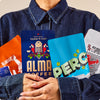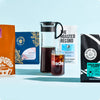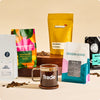As a coffee lover, you’ve likely had opportunities at your local cafe or through any of the lovely offerings here at Trade to explore blends and single origins.
Did you ever consider that some of your favorite teas might also be blended? And what about single origins? Are those a thing with tea, too?
Let’s explore!
Review: Why do we blend coffees and teas?
First, a review about why we even have blends in the first place. We’ll start with volume.
Most of the food in your house likely comes from groups of farmers who sell their produce to a larger customer. A batch of apples at your grocery store labeled “Michigan grown” likely do not all come from one apple farm. The same is true for coffee and tea. Producers sell their output to a larger distributor, who then services other customers, including wholesalers, retailers. They pool resources to have enough volume to sell.
Improving quality is another reason to blend. Say you have one lot of Japanese sencha green tea that offers a deliciously smooth mouthfeel but the aroma isn’t too memorable, while another offers fantastic aromatics but both color and body are a little weak. You could combine them and create a more complex and delicious tea.
When we improve quality, we can also create consistency, too. Each blend becomes like a recipe that the producer or importer can adjust to maintain a particular flavor profile. Many pu’erh teas are blended for this reason, as the fermentation process itself creates a lot of natural variation in the tea as it ages. Pu’erh producers will blend, blend, blend to smooth out the edges and deepen the layers of flavor as they go.
So, our key reasons for blending in both coffee and tea: creating volume, improving quality, and maintaining consistency. Now let’s talk about single origins.
Understanding single origins versus blends
Logically, we might think that “single origin” would always mean not blended, or from only one producer or farm. But that’s not always the case. It’s actually a broader term than the name suggests.
Single origin can mean it comes from just one farm, sometimes. However, especially with tea, it’s more commonly applied to mean a single province or region. A great number of teas are sold in this way:
- Da Hong Pao oolong from Fujian, China
- Kukicha green tea from Kagoshima, Japan
- Silver tips white tea from Nuwara Eliya, Sri Lanka
All of these teas, on one hand, are single origin. They are not blended with teas from outside of their country or region. On the other hand, they are not all necessarily single lot. They could be blended with other batches from either the same farmer or from other farms in that area, especially when it comes to volume reasons. We still call them single origin, however, because they come from one specific region.
Coffee is often sold this way, too. Think about seeing “Guatemala Antigua” on a menu. Antigua is a region, not a farm or a producer.
Which brings us to a very tea-specific expression of blending: tea + non-tea ingredients.
From peppercorns to candied fruit: The modern tea day blend
Where coffee and tea completely differ is the evolution of the modern day blend. To many tea folks today, “blending” is not this technical, largely industry-facing process we’ve been talking about so far. For lots of tea enthusiasts and numerous small businesses across the country, tea blends are these wildly colorful and creative combinations of tea and non-tea ingredients.
- Think green tea mixed with almond slices, dried apples and flower petals.
- Black tea accented with cinnamon bark, orange peel, and vanilla flavoring.
- White tea with butterfly pea flower that turns the normally pale brew to a vivid ocean blue cup.
- Chamomile layered with mint, rooibos, and CBD extract - no actual tea - for enhancing bedtime calm.
These types of blends are an entirely contemporary creation, spearheaded by industry giants like Teavana and David’s Tea. And to a very large audience of tea drinkers in North America, this is “tea.” The notion that these are blends and not individual botanicals doesn’t even factor in consumer awareness. It’s all “just tea.”
The majority of loose leaf teas being sold in North America aren’t types like Japanese gyokuro or Taiwanese GABA oolong. They’re trend-setting, colorful, multi-ingredient blends, often with flavorings. The classic staple Earl Grey is the biggest example of this level of ubiquity - a blend of various origin black teas, combined with bergamot citrus flavoring.
Single origin teas are by definition rare
Revisiting our grocery store comparison, we can more deeply appreciate just how unusual single origin teas are in the marketplace. Think of your local farmer’s market and meeting the actual people who grow, harvest, and sell those veggies and fruits on the table in front of you. Your city may be the only region they serve. The volume and output of their farm is limited to this area. No one else in the country is eating those apples or melons or peppers.
There’s something truly special about that experience, and the same is true for single origin tea. Single origin teas are uncommon and rare, while most blends are produced for popular appeal, higher volume, and ease of distribution.
To be clear, this is not to imply that big blends aren’t of good quality or wildly creative or important vehicles for introducing the wide world of tea to people. They most definitely are! Not all tea should be rare and hard to get because, well, that’s elitist as heck. But the comparison is to just shine light on how precious and limited single origin teas actually are, so we can appreciate what makes them unique. Just like your local blueberries!
How do I know if my tea is blended? Does it matter?
The answer to this is complicated. Just like with coffee, sometimes the components of a tea blend are disclosed and sometimes they’re not.
Some styles of tea-only blends traditionally disclose at least the country or sometimes the region. A breakfast blend might name black teas from Yunnan, Assam, and Kenya, etc. But the more subtle single origin blends - those done for technical reasons, such improving quality or flavor profile - are likely not labeled. And that’s actually totally ok because it honestly doesn’t impact most people enjoying the tea.
When it comes to mixing in other non-tea ingredients, however, that’s a different story.
Per food safety laws, if your tea product has anything other than just Camellia sinensis tea, those extra ingredients must be listed on the label. This is for food allergy and transparency reasons. So if the label just says “green tea” or maybe “green tea from China,” for example, it should only contain green tea. If it has anything else, and certainly any of the eight major allergens, it must be declared.
This is also important not just for allergies but for other medical reasons, too. Wellness tea blends can contain herbs and botanicals that some folks might need to avoid. And if you’re caffeine sensitive, you’d likely want to know if a delicious sounding dessert tea with rooibos, cocoa shells, hazelnut pieces and vanilla bean also contained a caffeinated black tea.
Blends, flavors, and single origins to geek out on
For the breakfast table: Scottish Breakfast and Masala Chai
- I’m a sucker for those hefty black tea blends that fill you up and keep you cozy. Consider Scottish Breakfast, which has a touch of smoked black tea (Lapsang Souchong) to give it just the right amount of hygge.
- You might not have realized this until just now, but the beloved Masala Chai is also a blend! Sturdy black tea with black pepper, ginger, cardamom and sometimes clove and cinnamon. Served with hot milk and plenty of sugar.
Aromatherapy in a cup: Vietnamese Lotus Tea and Earl Grey Lavender
- Jasmine green tea is the world’s most popular scented tea (a process similar to flavoring and blending, but using aromatic agents like flowers). But admittedly, it’s not for everyone. Consider a lotus green tea from Vietnam as a meditative, soothing alternative. *note: this tea is very seasonal and sometimes disappears but it comes back, I promise!
- Another clever twist on a classic is Earl Grey Lavender, which is Earl Grey but with a sprinkle of lavender to tame the zesty bergamot nose. Delicious as a tea latte.
For collectors: Dancong oolong and Pu’erh
- Dancong oolongs are perhaps one of the most romantic visions in tea. With names like “almond fragrance,” “ginger lily,” and “sweet potato,” dancongs are unique cultivars that produce aromas so brilliantly charming and expressive, each tea carries that namesake and is grown in an orchard of the same name. Found only in Guangdong, China.
- There is perhaps no deeper exploration of tea geekery than the world of pu’erh - the traditional fermented teas of Yunnan, China. Details like mountain range, wild tree vs arbor, storage and fermentation conditions, pressed or loose leaf, bitter or sweet, age of the tree, age of the tea. Pu’erh hits all those notes.
At the end of the day, it always comes down to what you’re in the mood to enjoy. Some teas and blends are just pure comfort food, always easy to love and familiar. Others scratch more of that seeking and learning side of ourselves, the part that wants to know why this region tastes different from that one, or why this combination is just so magical.
So sip, savor and stay curious, tea friends!






